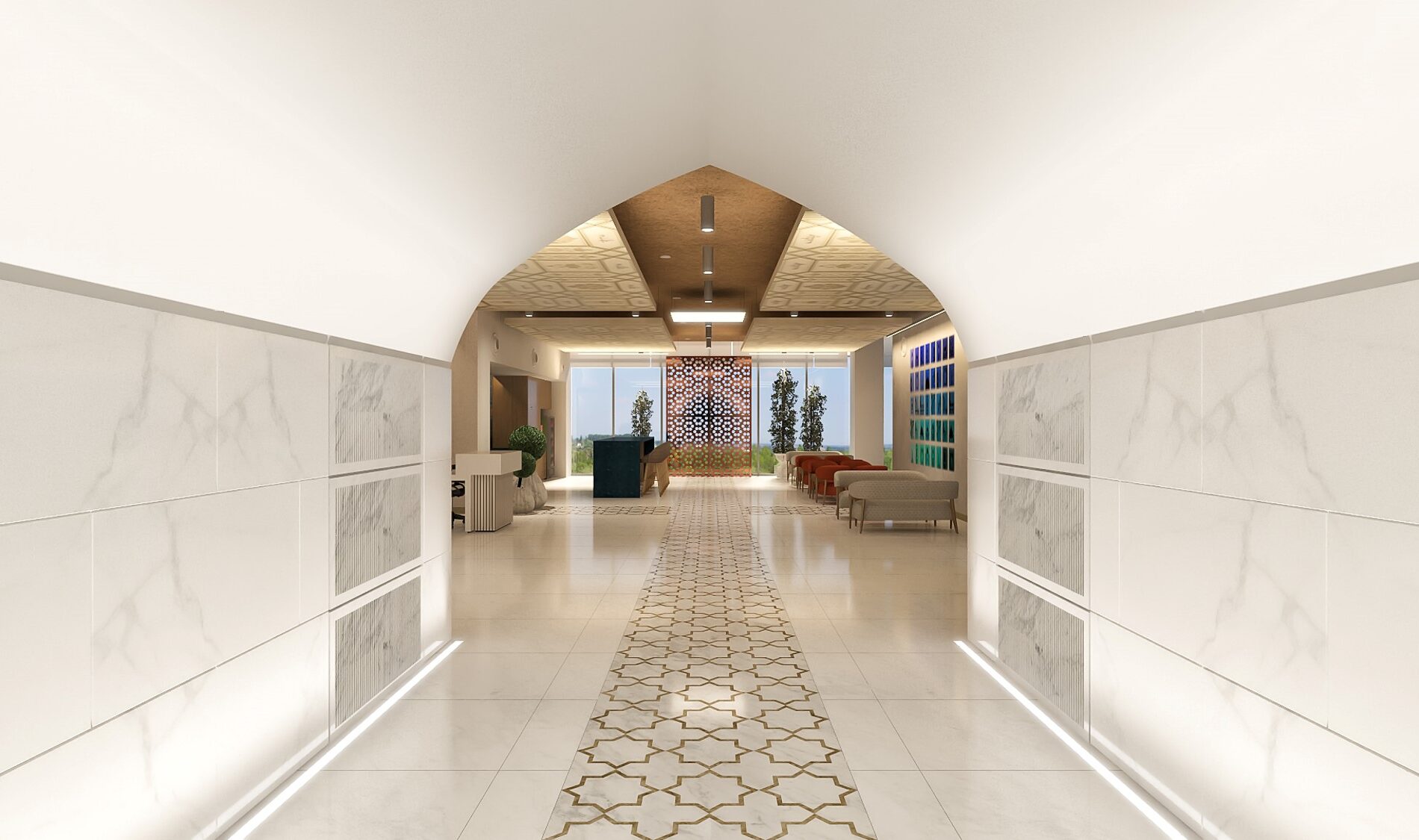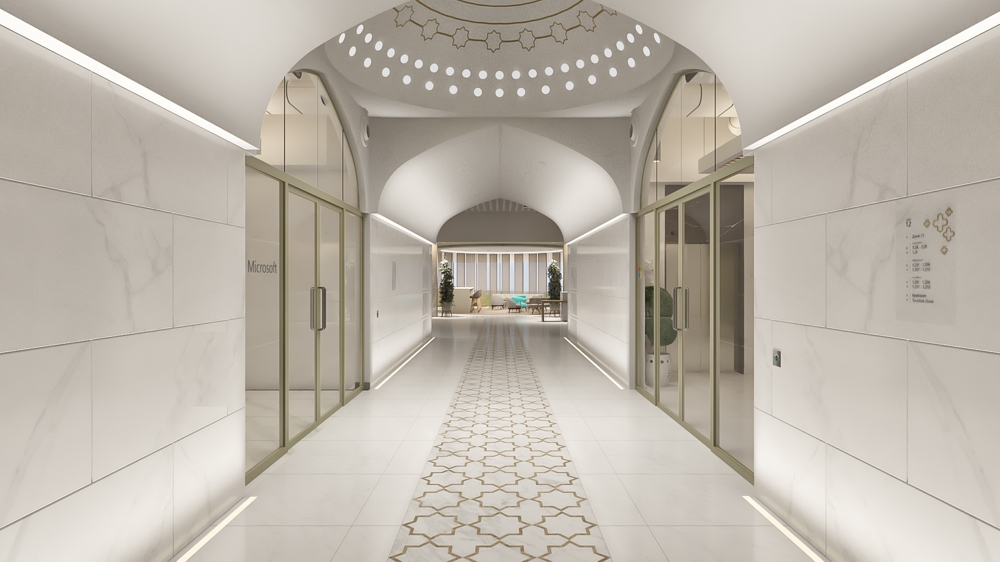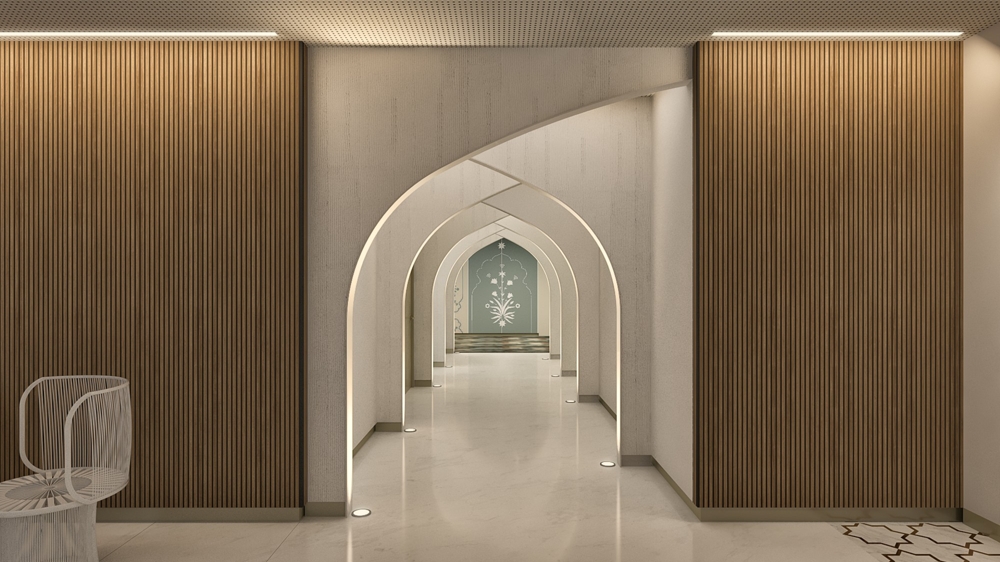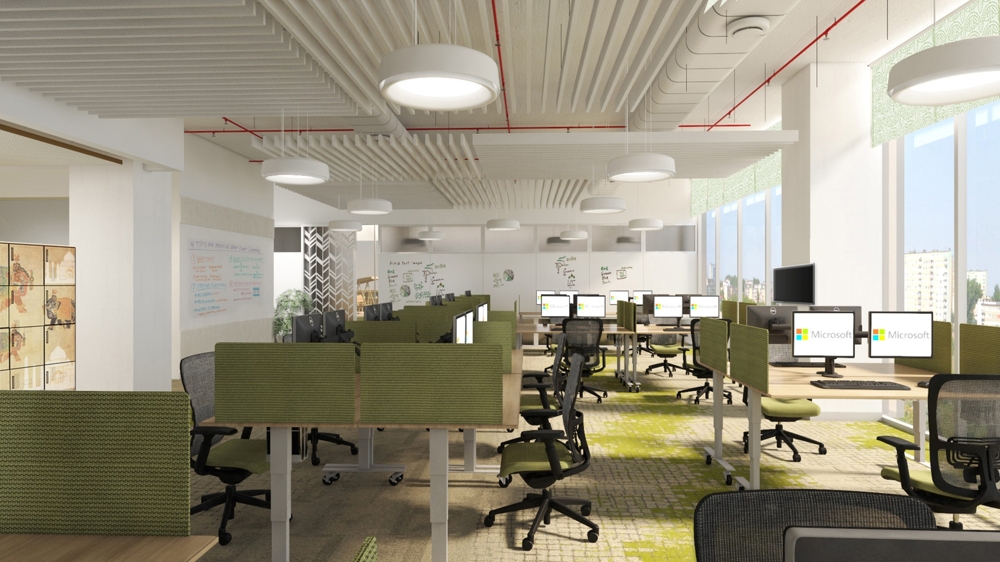
Inspired by the Taj Mahal, Microsoft’s newest office is a workspace of art
For some Microsoft engineers in India, coming back to office after the pandemic restrictions are eased will be an experience like no other. They will be in a new workspace that brings together the company’s guiding principle of tech-driven infrastructure merged seamlessly with the local cultural influence. In that, it sets a distinct tone for not just the returning employees, but also those who will begin their journeys here.
Spread across the top three floors of a six-story building in Noida, a satellite town of India’s capital New Delhi, this is the newest Microsoft India Development Center (IDC).
What sets the space apart from regular corporate workspaces is the historical context it draws from. Bathed in ivory white and punctuated with jaali work (a Mughal architectural style of perforated stone or latticed screen), arches, and domed ceilings, the IDC Noida campus’ architectural reference points, inspired by one of the world’s biggest architectural wonders, the Taj Mahal, are hard to miss.
The first IDC campus opened in Hyderabad in 1998, followed by another in Bengaluru. The Noida story is set to start a significant chapter in IDC’s vision.
“It’s really about two aspects,” says Rajiv Kumar, managing director, Microsoft IDC, and a Microsoft veteran of nearly 29 years. “One is to build a world-class product development organization in India. It’s a dream I had when I came back to India from Redmond in 2005 when there was nothing.”
India’s IT talent pool caters significantly to the world’s tech and engineering advancements and thrives in it.
“In order to attract the best talent from the country, you have to go to the places where they are,” says Kumar. “So, we started in the middle of the country when we opened Hyderabad center, and then went south with the Bengaluru center. My vision to create the Noida center was to attract the best talent that graduates from some of the world-class engineering and management institutions in the country’s north.”
The second aspect, Kumar adds, is how the IDC can cater to the next billion people in the world’s emerging market to realize Microsoft’s vision. “Our mission is to empower every person and every organization on this planet to achieve more,” he says. “That’s a very ambitious statement, but I feel the IDC owes it to the company to realize this mission.”
By being close to the capital, the Noida campus will enable more frequent collaboration with the government around developing technologies not only addressing India’s needs but also for similar regions around the world.
A monumental task

The Taj Mahal conjures up everything from the historical pursuit of architectural grandeur to plain romance. But it’s also more than that. English poet Sir Edwin Arnold described it as “not a piece of architecture, as other buildings are.” Which is why, even in the 21st century, this 17th century structure continues to intrigue and inspire.
When the team at Microsoft India started brainstorming on designing the site, situated on the highway connecting New Delhi and Agra, the theme was obvious to Jagvinder “Pinny” Mann, who managed the project as the lead for Real Estate and Facility (RE&F) at Microsoft India.
“What could be better than the Taj Mahal, the wonder of the world, for this space?” she says.
But transforming her vision into a space where hundreds of engineers would spend their working days was easier said than done.
“The Taj Mahal is one of the most distinctive buildings on the planet,” says Arunjot Singh Bhalla, managing director of RSP Design Consultants, explaining the thinking behind the interiors. “The challenge was: How does one possibly interpret the Taj Mahal and go one step further and apply it to an office?”
The space came together when the RE&F team and the creative teams at Bengaluru-based RSP Design Consultants sat down to draw the concepts from scratch and reference Microsoft’s design language.
“The Microsoft design language is a combination of general directions on what we want our offices to look like,” explains Riku Pentikainen, regional director-Asia at Microsoft RE&F. “It’s a combination of local culture, and being locally relevant, as well as incorporating hidden artifacts and items. We feel very good about being in the right place, at the right time.”
So, on one hand, the space is a visual ode to a bygone era. Yet it’s also a modern-day workplace like no other. The architects interpreted the Mughal architecture’s symmetrical and decorative aspects into a functional unit. They drew heavily from the Taj Mahal’s aesthetic materials including white marble sourced from Jaipur, along with inlay work with semi-precious stones.
The actual Taj Mahal is flanked on one side by the river Yamuna, and on the other by the Char Bagh Gardens. So in Noida, the architects took a cue from the natural surroundings of the actual site and translated them with the materials they had. The flow of the river became chevron patterns in the corridors, while the green of Char Bagh Gardens assumed the form of the color palette and textures in some parts of the Microsoft workspace that gives the illusion of the outdoors.
The Taj Mahal’s marble domes, minarets, arched entrances, jaali work, and even a visual reference to the Char Bagh Gardens, translate seamlessly in this Noida space. In the core area of the office space, archways and marble cladding create a sublime effect, while lattice perforations of the jaali screens — in marble or modified for the ceilings — render the space’s texture and depth. The subtle domes, at the same time, add volume.
The river also influences the incorporation of intersecting arches along the “river corridors,” is a direct reference to the Taj Mahal, and breaks the monotony of “corporate-looking” units such as conference rooms.
“We took the elements and were informed by the richness of the architecture of this amazing monument,” Bhalla says.
John Bowden, manager of Workplace Strategy, Asia Pacific Region at Microsoft, adds, “You don’t need to have diamond-studded walls to create something like this. It’s the concept, the form, the lighting, the materials used, and the color to create that atmosphere.”
Unlike most corporate or business offices, the Noida center is where the state-of-the-art, tech-driven workspace converges with a design scheme that references significant Mughal and Indian architecture. To spur the local economy, all the marble and fabrics were sourced from nearby regions.
The artwork called for artisans who could execute intricate tapestries and inlay work, while collaborating closely with the IT and facilities teams to create the intersectionality of form and function.
“We hired local artisans to do the inlays and paintings. It’s our way of helping the local talent so they can also add Microsoft in their profile,” says Mann.
When the pandemic struck and work at the site came to a standstill, the company provided the artisans with safe and hygienic accommodations as well as meals.
The new facility will accommodate the Xbox team — the first campus in India to host a gaming team.
This drive for playfulness comes together in a series of “surprise” elements across the workspace. A key example is the perforated jaali right at the entrance with the impression of the picture of Bill Gates, which is only visible at certain angles.
Yet another nod to the Taj Mahal was to paint a thousand elephants which, according to legend, carried marble stones to the Agra site. This story is painted on lockers at the Microsoft workspace by local artisans.
“These murals contain typical floral iconography,” says Bowden. “However, if you look closer, you realize the flowers are actually symbols from our cloud, our technology and our logo.” These easter eggs, Bowden adds, were a part of the design guidelines. This gamification of the workplace breaks the formula of traditional Indian workspaces. Here, the area interacts — even engages — with the user.
“We try to have fun,” he laughs.
A lot of the space reflects what the new generation wants in a workplace, based on research, Mann says.
“We have different kinds of seating for, say, when you want to have your meal, or if you want to be alone, or be in a spot where nobody disturbs you, or you take a 10-minute break,” she says. The public health considerations that were heightened because of the pandemic also resulted in automated doorways, along with distanced seating.
One of the crucial processes in the creation of space was sustainability. The base building is LEED platinum rated, which means it caters to the highest sustainability standards of construction and operation. The campus also includes recycled products and locally sourced materials including the marble, plus energy-saving light and water installations.
Bhalla adds that 2% of the office, which is in a city infamous for air pollution, is covered in greenery.
“We did a lot of study on the biophilia of the site, and the local plants that would survive in Noida,” he says.
The accessible workplace includes customized counters for wheelchairs, Braille signage, hazard warnings and access ramps.
Pentikainen describes the space as a “boutique” experience in which Microsoft’s vision to break away from the conventional and create a new path translates seamlessly into the Noida IDC. The Taj Mahal becomes more than just an architectural viewpoint, or a symbol of grandeur. It signals a vision that is ahead of its time and endures.
“I think working at an office is going to be a more beautiful experience than in the past because employees will have a choice,” Kumar says. “They can work from the comfort of home, or they can come to office and work in a world-class environment where they can collaborate, build social capital and forge a bond among themselves. I really believe that.”
Pallavi P. is a writer based in Mumbai whose work focuses on the intersection of culture, society and architecture in India.





